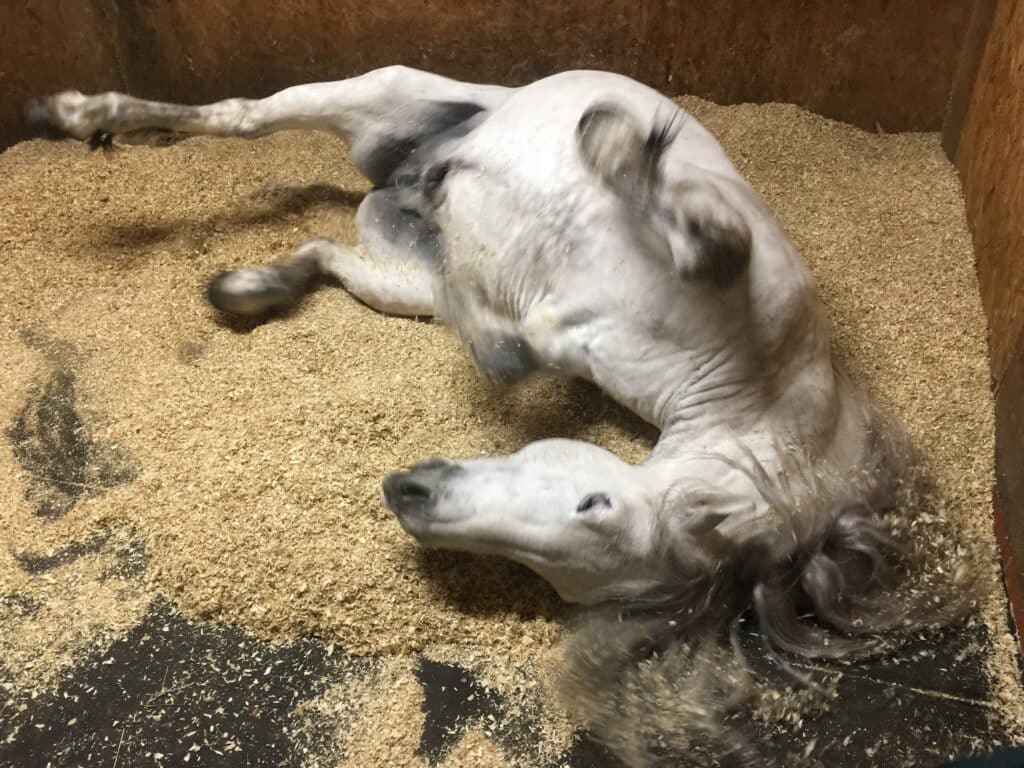Colic, Veterinary
Why should you call the vet if your horse shows signs of colic?
Emmeline Hannelly MSc, Welfare Education Manager, The British Horse Society, begins the first in our series supporting the REACT campaign
On exactly the same day, a few weeks ago, two friends’ ponies suffered with colic. Both cases were very different in their nature and circumstances. However, the one thing the cases had in common, was that earlier in the day everything had been absolutely fine but later on, the signs of colic were apparent; for one case they were subtle and the other it was abundantly clear. The owners did not delay and called their vet immediately; one pony was diagnosed with tympanic (gas) colic and the other was referred to their nearest equine hospital for emergency surgery.
Time is of the essence with colic, but especially in critical cases, where the intestine’s blood supply has become compromised. In the surgical case, the time from when the colic was first spotted, to calling the vet, the vet getting to the yard, the vet’s assessment and getting the trailer hitched up, and the pony en route to the hospital, was less than 90 minutes. By reacting so quickly, both owners gave their ponies the best chance possible.
Research by the University of Nottingham found colic accounted for one in three emergency vet call outs to horses¹. The same group also found that in 47% of colic cases, the horse had recently had a change of management, and the majority of evidence on risk factors for colic related to management change ² ³. Therefore, at this time of year owners should take particular care to ensure any changes to their horses’ management and feeding are made gradually. Horse owners, or the main person responsible for the care of horses, play a vital role in recognising the early signs of colic. Colic cases can quickly deteriorate; early recognition and prompt veterinary attention is vital to increase the chance of recovery for the horse. Colic can happen to any equine at any time so, if you notice any change in your horse’s behaviour or, they are showing signs of distress, think REACT and contact your vet.
The REACT colic information is based on five signs which are the most common and important indicators of colic. The descriptions for each of the five areas (for example, flank watching, pawing, kicking at belly for abdominal pain) are listed in order of prevalence⁴. Horses may show any of these signs, and it is important that owners/carers contact their vet if any of these signs are observed or, there are any concerns. Colic has long been associated with the more classic signs such as flank watching, kicking at the stomach or constant rolling. However, these signs are not seen in every case, and therefore waiting for them to be displayed may delay diagnosing a problem or cause one to be missed completely.
Horses respond differently to being in pain, some, especially donkeys, can be more stoic (endure pain without showing clear signs) so even the most subtle of signs could be a case of colic and potentially critical colic. Other signs, such as eating less or passing fewer droppings, are more commonly seen and are important in recognising a problem early. Be aware, in cases such as impaction colic, depending on where the blockage is within your horse’s gut, your horse may still pass droppings. Therefore, monitoring the change in number and consistency of droppings is important.

The REACT signs are not an exhaustive list of every possible sign of colic but instead, highlight five key aspects of your horse’s health and behaviour that should be considered. In respect of the outcome of my two friends’ ponies, I am saddened to say they both had a tragic outcome. The first was an aged pony (late 30s) and despite numerous visits by the vet throughout the afternoon and into the early hours, the pony’s condition significantly deteriorated, and euthanasia was opted for. By contacting the vet immediately, it enabled the pony to receive pain relief and veterinary attention throughout, which minimised the suffering and allowed an earlier decision to be made.
In the case of the pony who went for surgery, the actual procedure was a success, with the cause being a lipoma (fatty tissue) strangulating the gut. Within a week, a high temperature gave cause for concern and upon investigation an internal abscess around the kidney was a secondary complication that couldn’t be treated. The owner made their way to the hospital to be with her beloved pony when he was euthanised.
The British Horse Society and the University of Nottingham launched ‘REACT Now to Beat Colic’ to help raise awareness of colic, especially the more subtle signs, to have a provisional plan in place should their horse be diagnosed with critical colic. For more information, videos and to download a free Care and Emergency Plan visit bhs.org.uk/colic.
References
- Bowden A, Boynova P, Brennan ML, England GCW, Mair TS, Furness WA, Freeman SL, Burford JH. (2020) Retrospective case series to identify the most common conditions seen ‘out-of-hours’ by first-opinion equine veterinary practitioners. Vet Record. 14;187(10).
- Curtis L, Burford JH, Thomas JS, Curran ML, Bayes TC, England GC, Freeman SL. (2015) Prospective study of the primary evaluation of 1016 horses with clinical signs of abdominal pain by veterinary practitioners, and the differentiation of critical and non-critical cases. Acta Veterinaria Scandinavica. 6; 57:69.
- Curtis L, Burford JH, England GCW, Freeman SL. (2019) Risk factors for acute abdominal pain (colic) in the adult horse: A scoping review of risk factors, and a systematic review of the effect of management-related changes. PLoS One. 11;14(7).
- Freeman, S.L. and Curtis, L. (2015) Developing best practice guidelines on equine colic. Vet Record 176: 38-40
